Posted by: Northwest Eye in General on August 1, 2025
Overview
We understand that experiencing eye pain can be distressing. The main symptoms of corneal ulcers that should never be ignored include:
- Severe eye pain
- Blurred vision
- Redness
- Increased sensitivity to light
- Discharge
Each of these symptoms can indicate serious underlying issues that require immediate medical attention. Recognizing these symptoms is crucial, as timely intervention can prevent complications such as permanent vision loss. We want to reassure you that seeking help can lead to better treatment outcomes. Remember, you are not alone in this; we are here to help you through this process.
Introduction
Severe eye pain, blurred vision, and persistent irritation—these symptoms can signal a serious condition that may be lurking beneath the surface. Corneal ulcers, often overlooked, pose significant risks to your eye health and vision. We understand that experiencing these symptoms can be frightening. This article delves into ten critical symptoms that should never be ignored, empowering you to recognize the urgent signs of corneal ulcers and seek timely medical intervention.
It’s common to feel overwhelmed when faced with such warning signals. Understanding the implications of these symptoms could mean the difference between preserving your sight and facing irreversible damage. We are here to help you through this process.
Severe Eye Pain: A Warning Sign of Corneal Ulcers
Severe eye pain can be an alarming experience, often felt as a sharp, throbbing sensation or a constant ache, and it may indicate corneal ulcer symptoms. Many patients describe it as if something is lodged in the eye, which can understandably cause distress. This pain frequently intensifies with light exposure or movement, which are important that should never be overlooked.
Corneal lesions are considered a medical emergency, requiring prompt intervention by an eye care professional. If left untreated, these lesions can lead to permanent scarring and loss of sight. Recent studies have shown that corneal ulcer symptoms, including intense eye discomfort, are common among individuals with eye lesions, highlighting the importance of seeking immediate consultation with an eye care specialist for accurate diagnosis and timely treatment.
Eye specialists stress that managing corneal ulcer symptoms and intense eye discomfort quickly is vital. Neglected eye sores can result in irreversible sight impairment. We understand that this can be a frightening situation, but it’s essential to act swiftly. As one expert noted, ‘The diagnosis should be considered in patients presenting with these classic findings,’ emphasizing the importance of recognizing this symptom as a potential ocular emergency.
If you experience severe eye pain, we urge you to seek medical attention immediately. Taking this step can help prevent complications and ensure you receive the care you need. Remember, we are here to help you through this process.
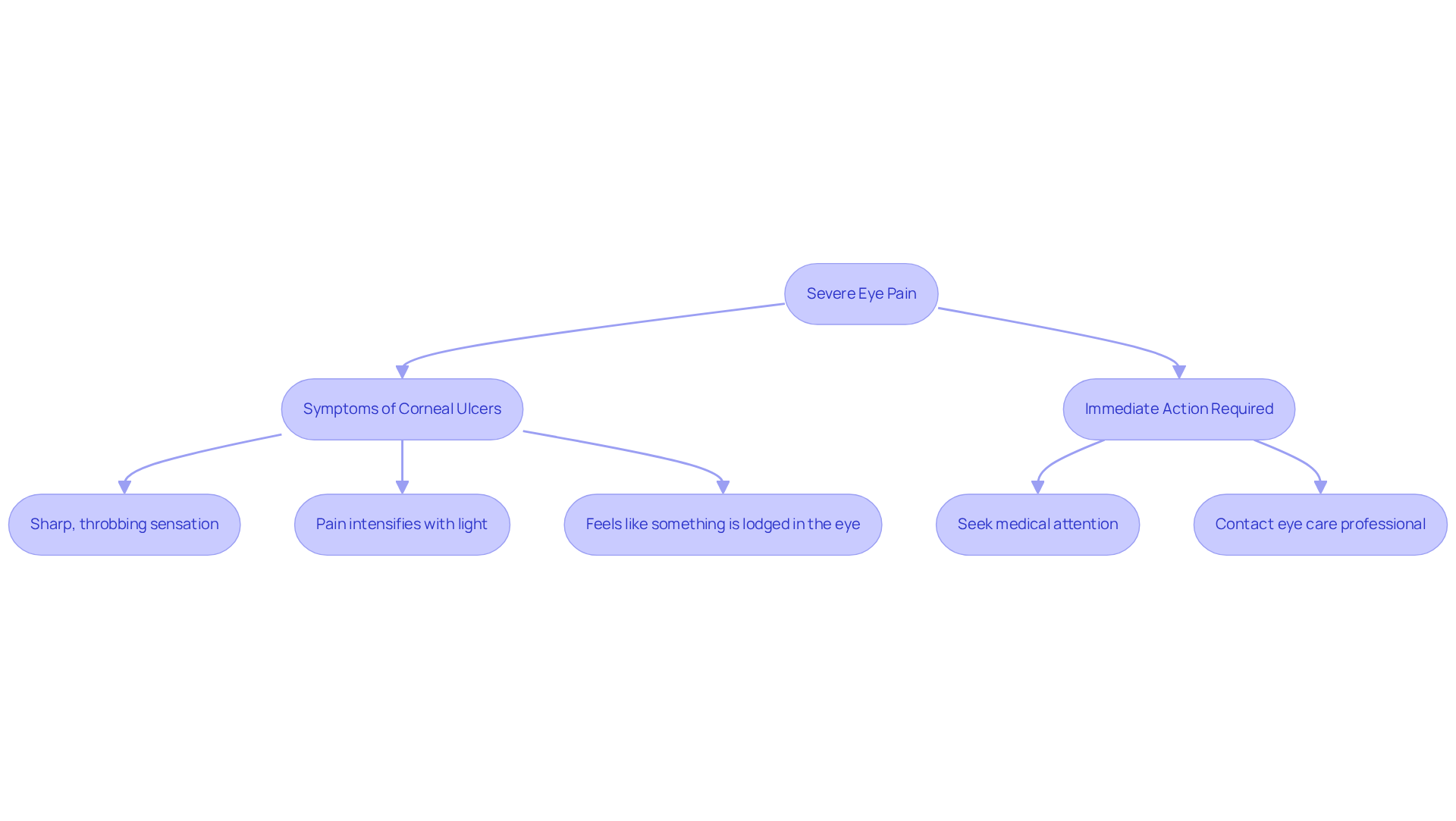
Blurred Vision: Recognizing a Potential Corneal Ulcer
Blurred sight can appear either abruptly or progressively, depending on the intensity of the eye sore. We understand that patients frequently describe their vision as hazy or distorted, which can significantly interfere with daily activities such as reading, driving, or even recognizing faces. Research shows that around 50% of individuals with eye lesions report having unclear sight as a main symptom. This symptom, particularly when accompanied by pain or redness, is one of the corneal ulcer symptoms that necessitates immediate medical attention to avert potential complications.
Ophthalmologists stress that blurred sight is not just a nuisance; it can indicate serious underlying problems, such as corneal ulcer symptoms, that require prompt intervention. Dr. Emily Carter, an eye specialist, mentions that blurred sight is frequently the initial indicator of corneal ulcer symptoms, which must never be overlooked. It’s common to feel concerned when experiencing such symptoms.
For instance, Tori Spelling’s experience with an eye sore, which she openly discussed, highlights the critical importance of recognizing unclear sight as a warning sign. Her case serves as a reminder of the importance of proper contact lens care, as she admitted to wearing daily lenses for extended periods without removal, leading to her eye condition.
Treatment for corneal ulcers typically involves antibiotic, antifungal, or antiviral eye drops, depending on the cause. If you observe any changes in your eyesight, especially if they are abrupt or accompanied by corneal ulcer symptoms, it is vital to obtain a professional assessment to safeguard your sight. We encourage and tracking alterations in your vision, as these proactive measures can help preserve your eye health.
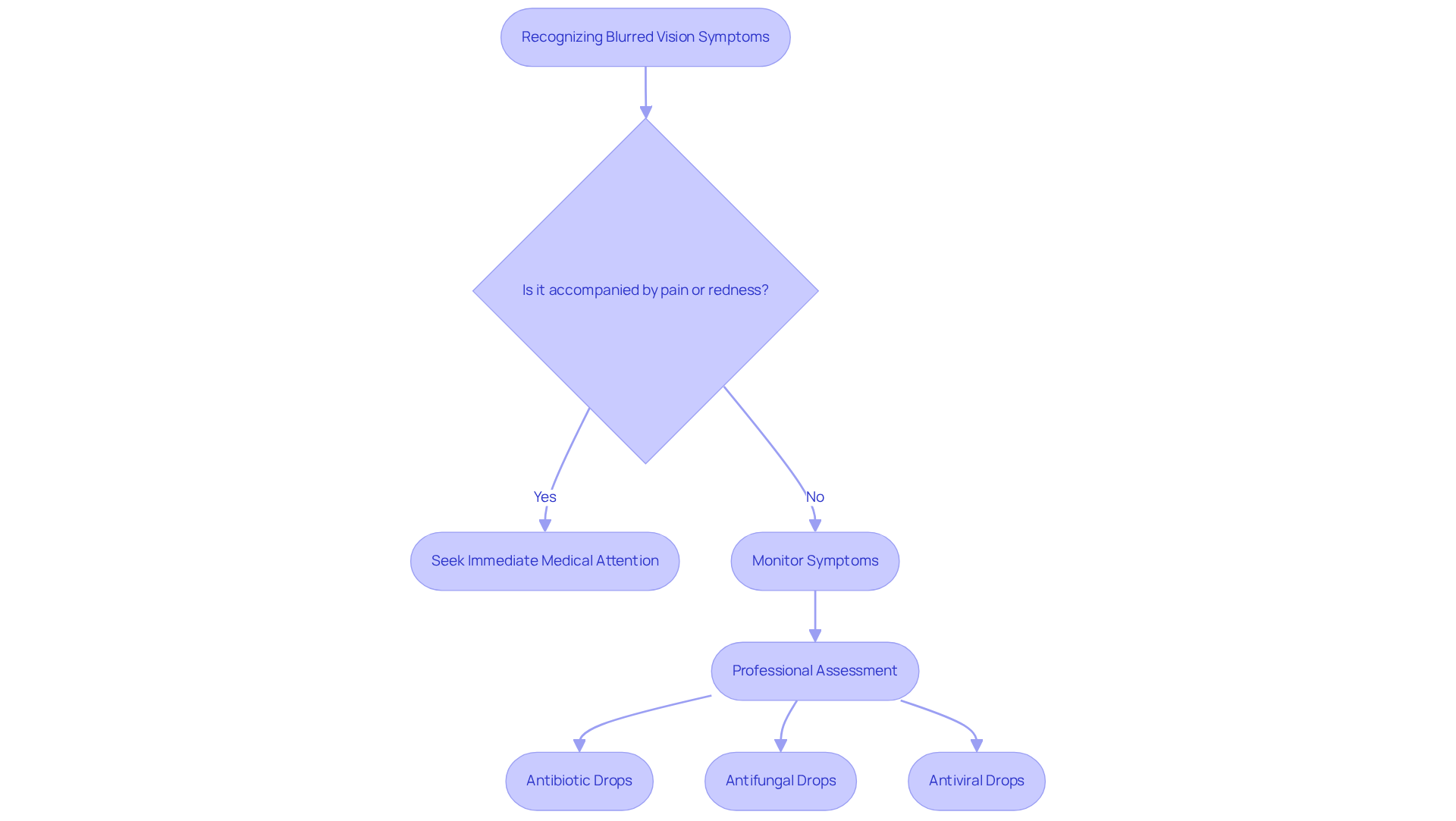
Redness in the Eye: An Indicator of Corneal Ulcer Issues
Eye redness, often called bloodshot eyes, can appear as either localized or widespread discoloration. This symptom results from increased blood flow to the affected area, a natural response by the body to infection or injury. We understand that in cases of eye sores, this redness may come with like discomfort, discharge, or blurred vision, indicating a serious condition that requires prompt attention. Statistics reveal that untreated eye sores can lead to permanent vision loss in about 20% of cases, underscoring the importance of early diagnosis and intervention.
It’s common to feel anxious about significant eye redness resulting from surface injuries. Many patients report a notable decline in their quality of life during these times, prompting them to seek immediate medical attention. Dr. Melody Huang, an eye care professional, emphasizes, “Any redness, especially when paired with discomfort or discharge, should not be overlooked, as it may signal an underlying issue that could escalate without proper intervention.”
Moreover, maintaining proper eye care routines, such as effectively cleaning contact lenses and avoiding sleeping in them, can significantly reduce the risk of developing eye sores. We are here to help you through this process, and prompt consultation with an eye specialist is essential for effective management and to prevent potential complications.
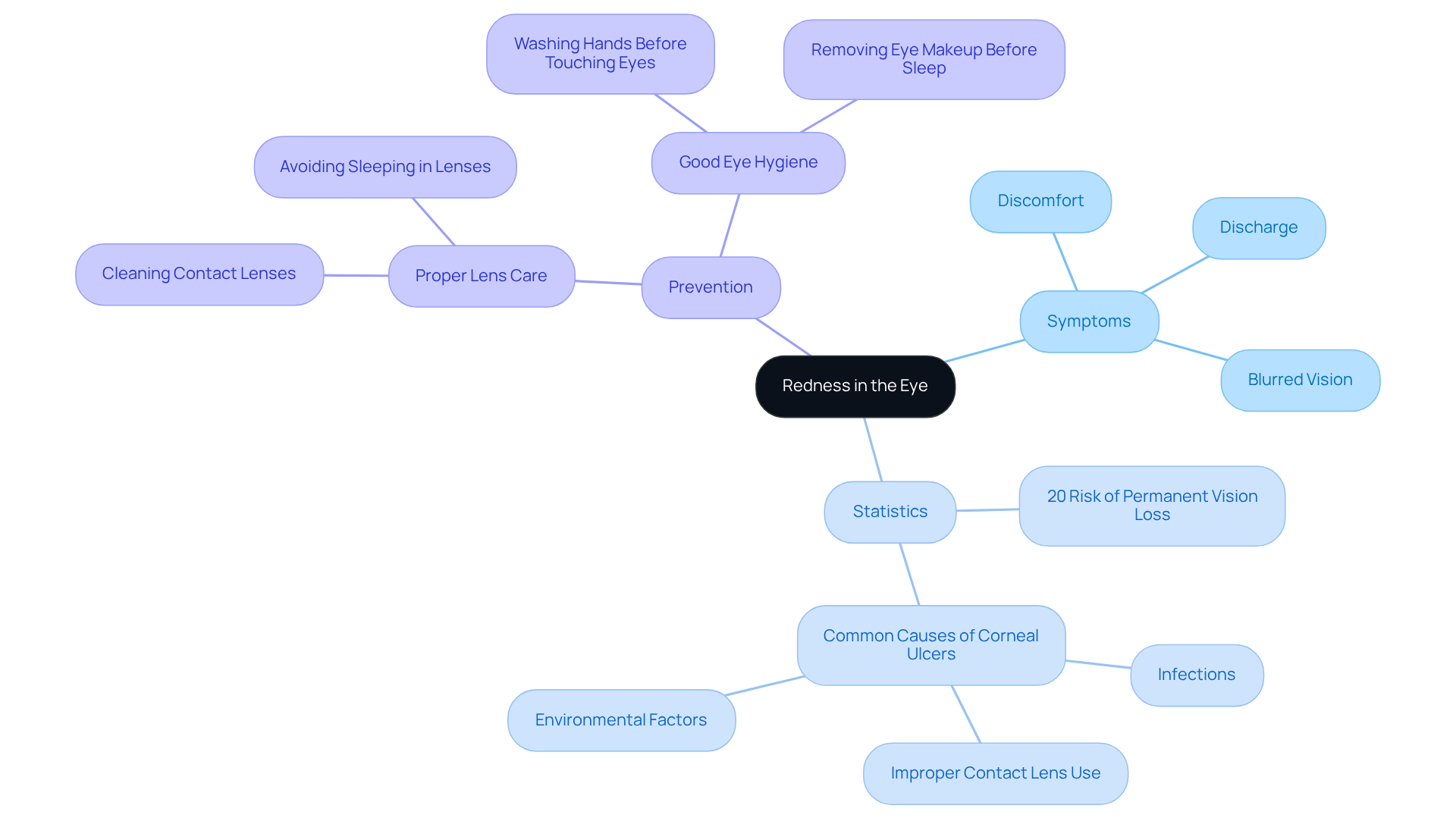
Increased Sensitivity to Light: A Symptom Not to Overlook
We understand that increased sensitivity to light can be quite uncomfortable and may even cause pain in bright environments. Many patients find themselves squinting or, at times, avoiding light altogether. This experience can be distressing, and it’s important to recognize that corneal ulcer symptoms often indicate that the cornea may be inflamed or damaged.
We encourage you to seek a , as addressing these concerns is vital for your well-being.
Tearing or Discharge: Signs of Corneal Ulcer Development
We understand that individuals with often face challenges such as excessive tearing or a thick discharge from the affected eye. This discharge can vary in appearance—clear, yellow, or green—depending on the underlying cause. It’s important to note that a significant statistic reveals that 71% of samples collected from contact lens users showed the presence of microbial organisms. This highlights the increased risk factors for eye infections among these individuals.
If you notice a sudden increase in tearing or discharge, especially when accompanied by corneal ulcer symptoms such as redness or pain, it’s crucial to consult an eye care professional without delay. Eye specialists emphasize the importance of recognizing corneal ulcer symptoms early, as it can greatly impact treatment outcomes. This is particularly vital in underserved populations where timely intervention is often lacking.
A study involving 205 patients diagnosed with eye lesions found that timely diagnosis and referral to specialized care improved clinical outcomes, with only 20% needing surgical intervention after three months. Additionally, older patients and those with central lesion locations may face extra challenges in treatment.
Therefore, being vigilant about changes in eye discharge is essential for maintaining eye health and preventing complications. As noted in the Journal of Ophthalmic Inflammation and Infection, timely diagnosis and prompt referral to subspecialty care are crucial for optimizing clinical outcomes. Always monitor your symptoms closely and seek timely care to ensure the best possible outcomes. We are here to help you through this process.
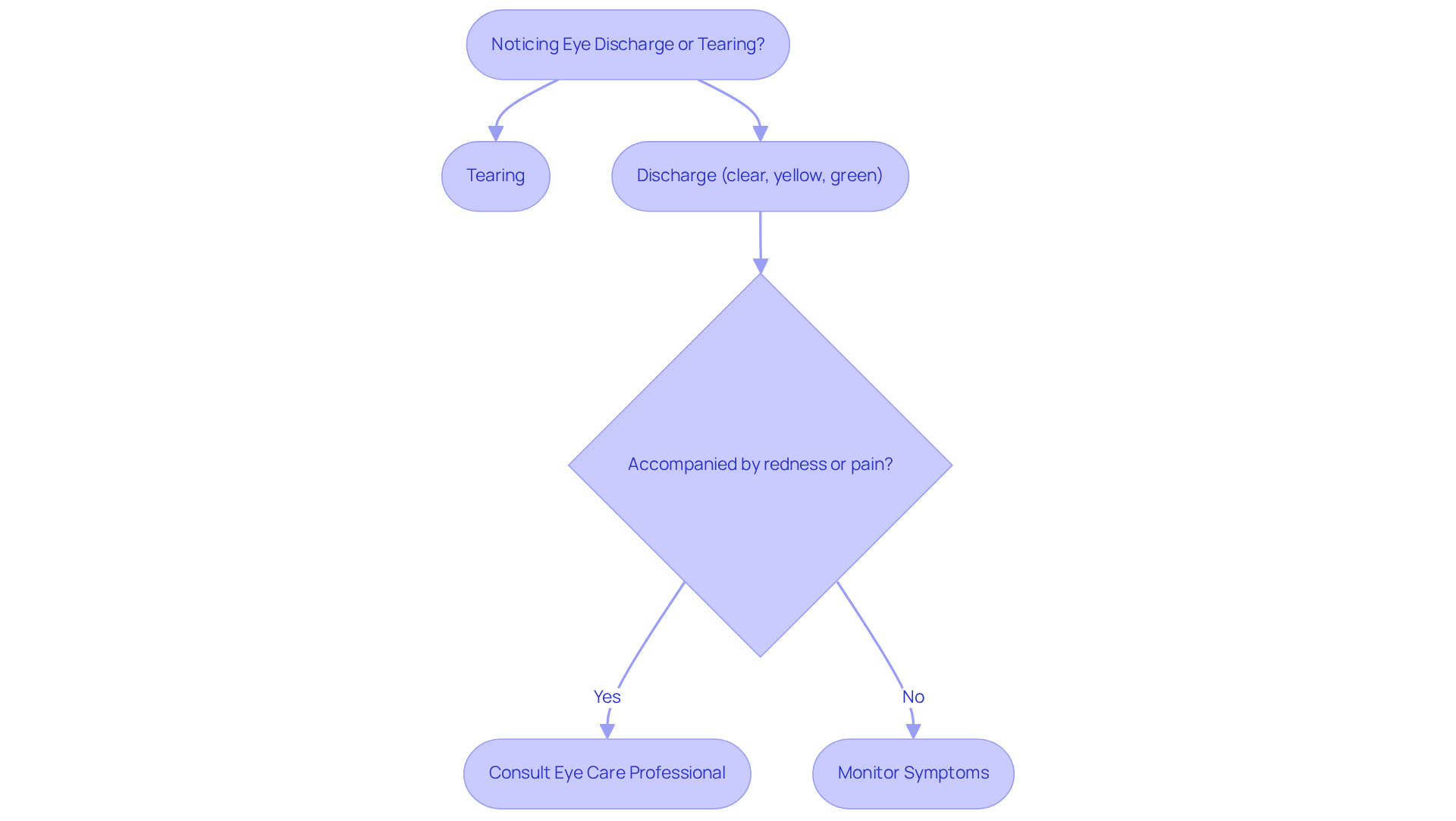
Swelling of the Eyelids: A Critical Symptom of Corneal Ulcers
Eyelid swelling can be a concerning sign of inflammation related to eye surface lesions. This swelling often appears alongside redness and tenderness, which may indicate a potential medical emergency. It’s important to recognize that eyelid swelling is frequently reported as a symptom of corneal ulcer symptoms in patients with eye surface lesions, highlighting its common presence in clinical observations. For instance, a patient who experienced eyelid swelling due to an eye condition reported severe eye pain and discharge, underscoring the urgent need for medical assessment to prevent serious complications.
We understand that recognizing eyelid swelling can be alarming. Ophthalmologists emphasize the significance of this symptom. As one expert noted, “The presence of eyelid swelling, particularly when combined with other symptoms like pain and discharge, should prompt urgent medical attention to prevent further deterioration of eye health.” Timely care is crucial, as untreated eye sores can lead to or even the loss of the eye. Therefore, if you notice eyelid swelling along with corneal ulcer symptoms like excessive tearing or sensitivity to light, it is imperative to seek professional care without delay.
We are here to help you through this process and ensure your well-being. Remember, you are not alone in this; many others have faced similar concerns and found reassurance through prompt medical attention.
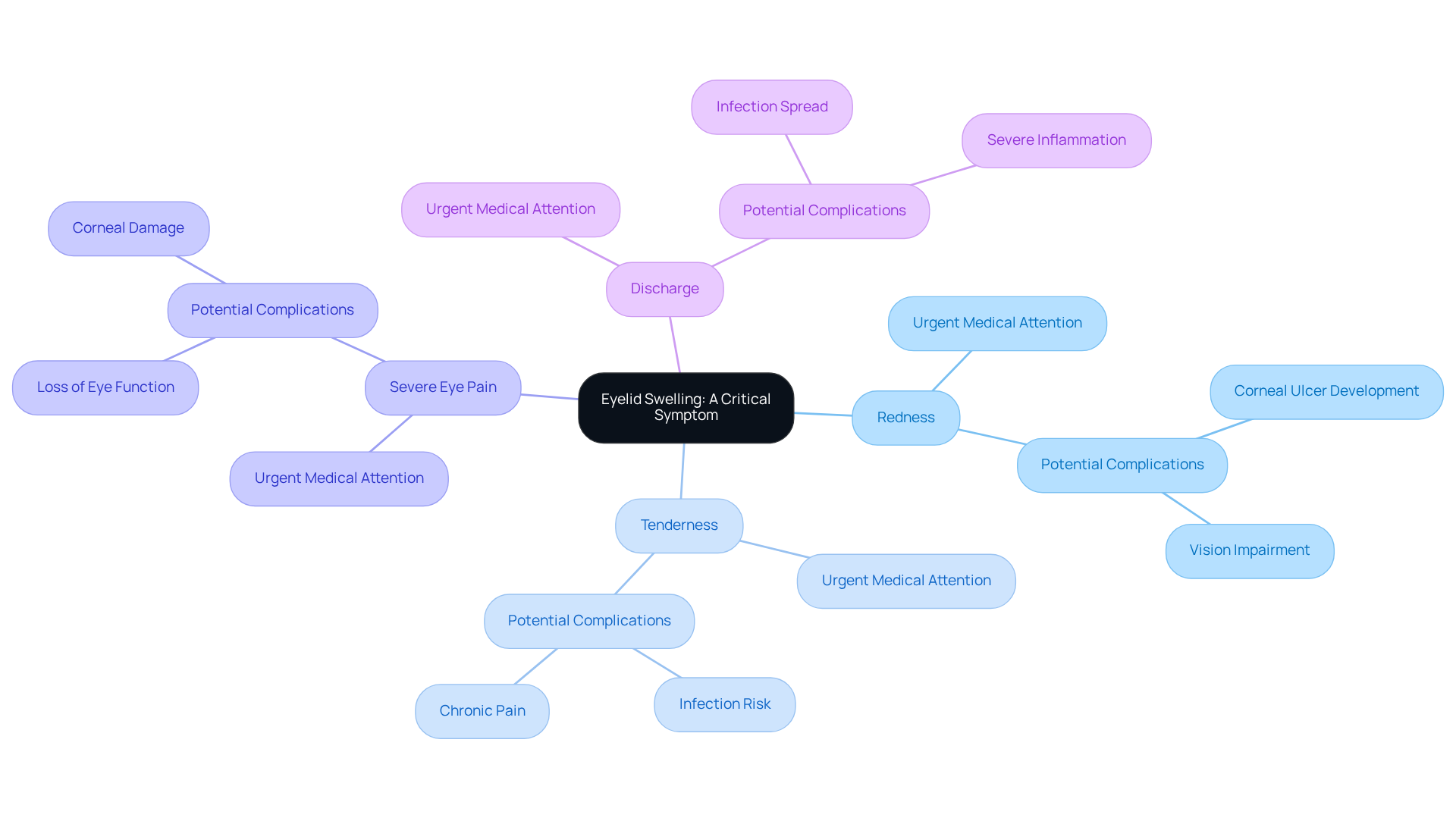
Persistent Eye Irritation: A Key Symptom to Monitor
Ongoing eye discomfort, often described as a gritty or scratchy feeling, can be a sign of corneal ulcer symptoms. We understand that many patients report a , leading to significant discomfort and distress. If this feeling persists, it’s important not to overlook it.
Statistics show that a considerable number of individuals experiencing eye irritation may be at risk for more serious conditions, including symptoms of corneal ulcers. Therefore, we encourage you to consult an eye care professional for a thorough evaluation and appropriate treatment if these symptoms continue.
Early intervention can prevent complications and ensure better outcomes for your eye health. Remember, we are here to help you through this process.
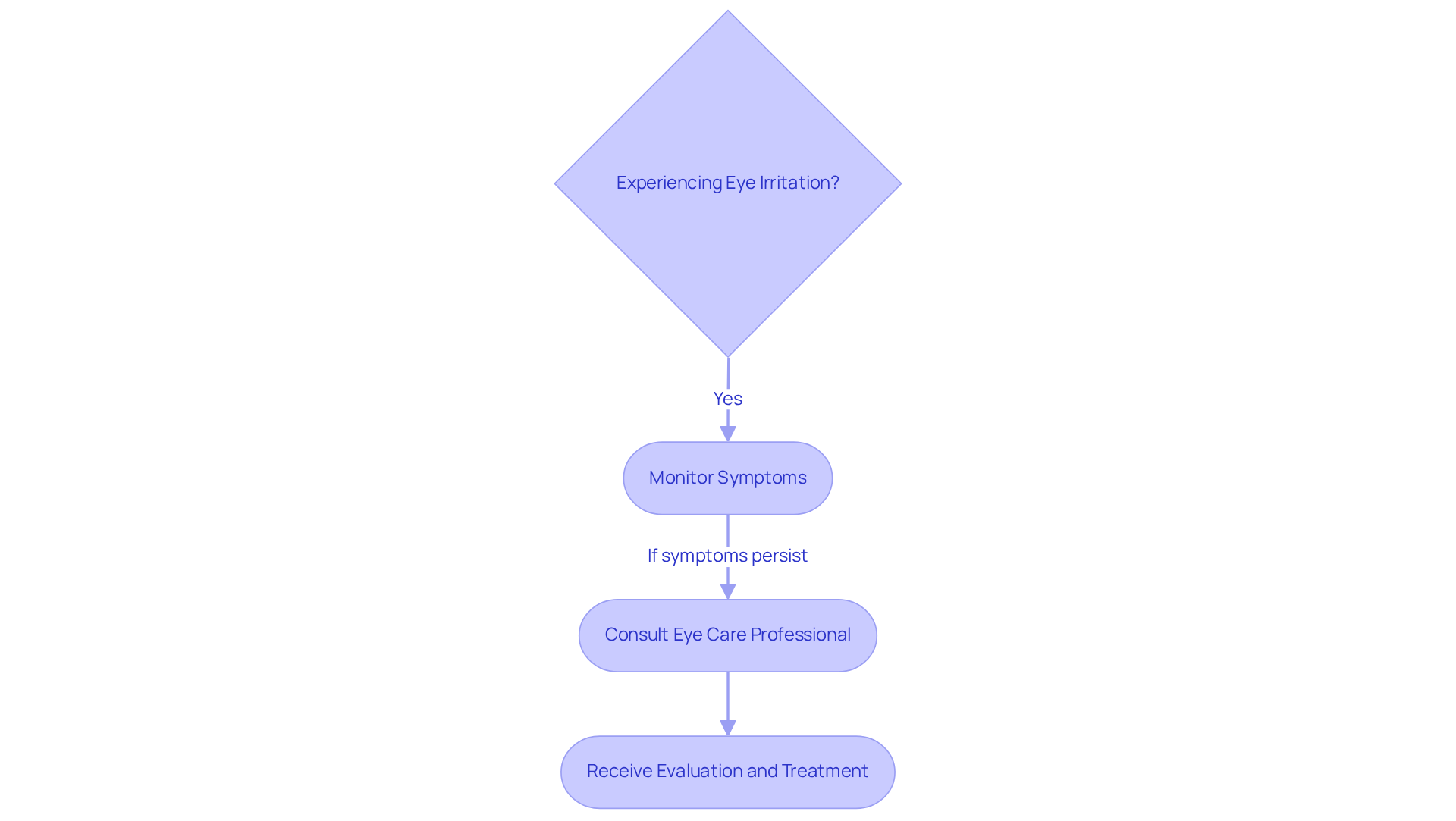
Changes in Eye Color: A Potential Sign of Corneal Ulcers
Alterations in eye color, especially a cloudy or hazy appearance, can be a crucial sign of potential damage or infection in the eye’s tissue. We understand that noticing these changes can be concerning. This symptom often appears alongside and other signs of irritation, such as redness, excessive tearing, or discomfort. Research indicates that blurred vision and sensitivity to light are common among individuals experiencing opacity of the eye, with reports suggesting that up to 30% of patients may display these symptoms.
If you observe any changes in the color of your eye, it is important to seek medical attention promptly to identify the underlying cause. Dr. Rebekah H. Gensure, a vitreoretinal surgeon, emphasizes, “Noticing variations in eye color can be crucial for early identification and care of eye lesions.” Eye care specialists reinforce that early intervention can greatly enhance outcomes. Prompt diagnosis and treatment are essential in effectively managing eye lesions.
For example, individuals experiencing corneal ulcer symptoms may notice a change in eye color due to infection or irritation. Remember, your eye health is vital, and recognizing these changes can be the first step toward maintaining your sight. We are here to help you through this process, ensuring you receive the care you need.
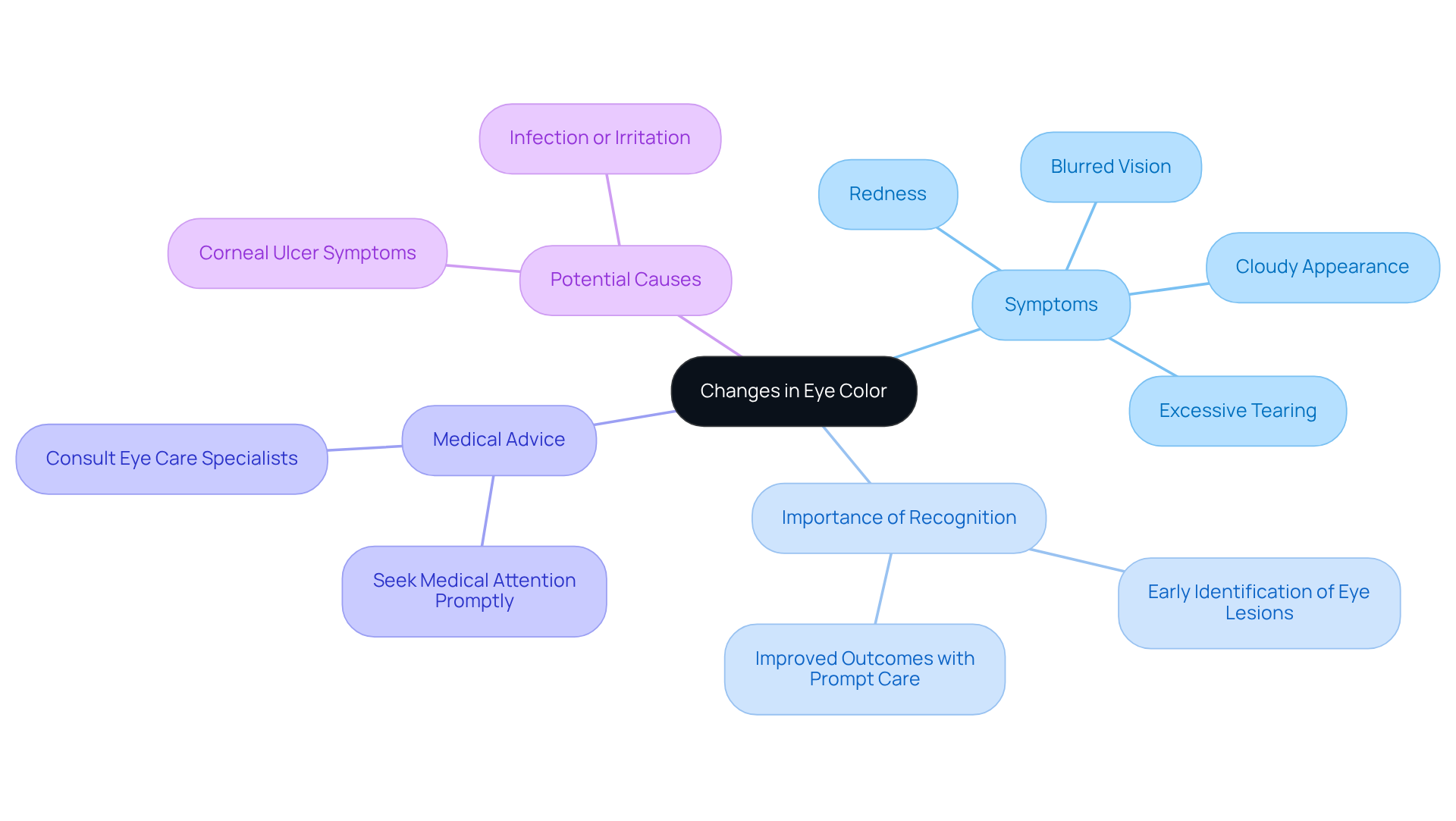
Headaches: A Related Symptom of Corneal Ulcer Issues
Headaches can often arise from eye strain or discomfort linked to corneal ulcer symptoms. We understand that this can be distressing. Patients may experience tension headaches or migraines, characterized by pain and heightened sensitivity due to their eye condition. Symptoms such as blurred vision, light sensitivity, and discomfort can exacerbate these headaches. Therefore, it’s crucial to seek when they occur alongside other signs.
Neurologists stress that headaches located behind the orbits, commonly known as retro-orbital headaches, can greatly affect daily life. It’s common to feel overwhelmed by these symptoms. In fact, studies indicate that nearly 50% of American adults struggle with understanding health information, highlighting the importance of clear communication regarding symptoms and treatment options.
If headaches persist or are accompanied by corneal ulcer symptoms such as red, bloodshot eyes or visual disturbances, consulting an eye care professional is essential for a thorough assessment and appropriate management. We are here to help you through this process and ensure you receive the care you need.
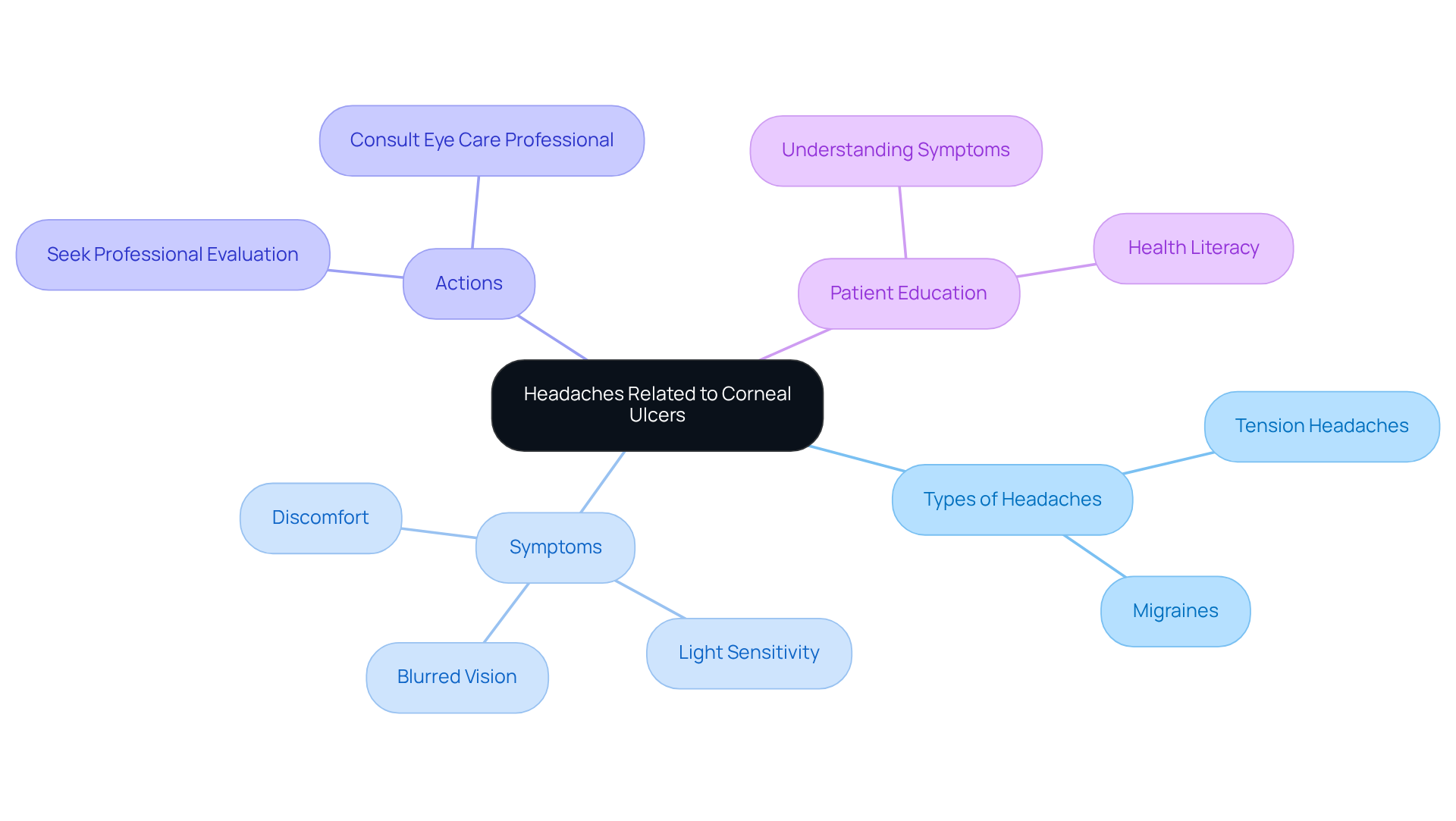
Vision Loss: A Critical Symptom of Corneal Ulcers
Vision loss, whether partial or complete, can be a significant warning sign of severe corneal ulcer symptoms. We understand that abrupt changes in sight can be alarming, and it’s crucial to seek . Research shows that timely intervention can be pivotal in preventing irreversible damage and preserving vision.
Consider the recent experience of a young woman, Steph Carrasco, who faced the possibility of blindness due to an eye condition worsened by improper contact lens usage. Her journey underscores the importance of recognizing corneal ulcer symptoms early, which include:
- Chronic itching
- Watery eyes
- Light sensitivity
Eye specialists, including Dr. Jack Brenton, stress that any signs of sight loss should prompt immediate assessment. Untreated eye sores can lead to serious complications, including lasting sight damage. The prevalence of vision loss in patients with advanced corneal ulcer symptoms is concerning, reinforcing the need for awareness and prompt action.
Ignoring these symptoms can lead to dire consequences. It’s essential to seek help at the first sign of trouble. We are here to help you through this process and ensure you receive the care you deserve.
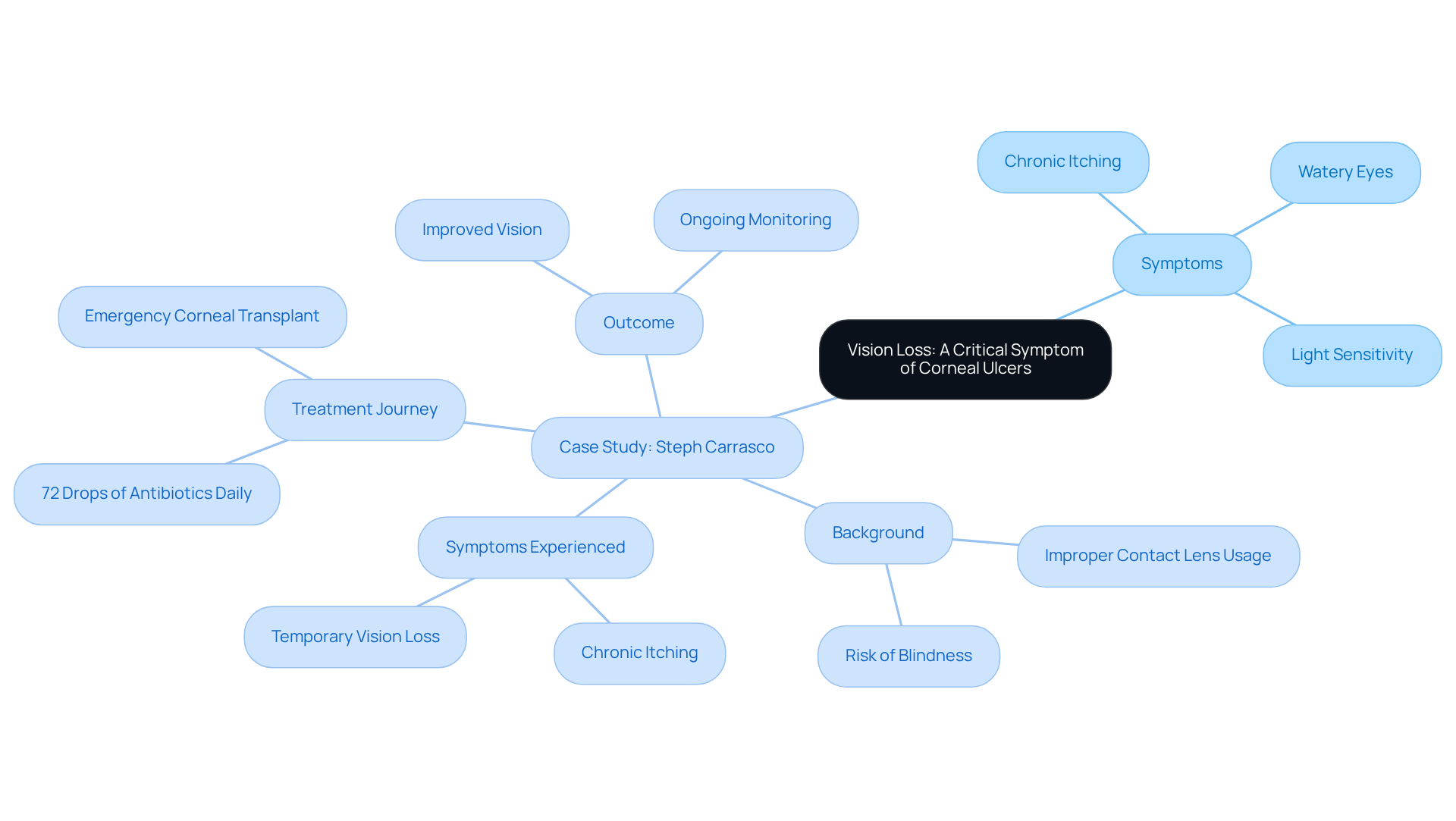
Conclusion
Recognizing the symptoms of corneal ulcers is crucial for maintaining your eye health and preventing serious complications. We understand that experiencing eye issues can be concerning. This article highlights ten key symptoms that should never be ignored, including:
- Severe eye pain
- Blurred vision
- Redness
- Increased sensitivity to light
Each of these indicators serves as a warning sign that immediate medical attention is necessary to prevent irreversible damage to your eye.
It’s common to feel anxious when facing persistent eye irritation, tearing, or changes in eye color. Each symptom not only affects your daily life but can also lead to significant vision loss if left untreated. The real-life cases discussed illustrate the potential consequences of ignoring these warning signs, reinforcing the need for vigilance and regular eye check-ups.
Ultimately, proactive management of your eye health is essential. If you experience any of these symptoms, please seek professional evaluation without delay. By prioritizing eye care and being aware of the signs of corneal ulcers, you can safeguard your vision and overall well-being. Remember, timely intervention can make all the difference in preserving your eye health and preventing complications. We are here to help you through this process.
Frequently Asked Questions
What is severe eye pain a warning sign of?
Severe eye pain can indicate symptoms of corneal ulcers. It is often described as a sharp, throbbing sensation or a constant ache and may feel like something is lodged in the eye.
Why is it important to seek medical attention for severe eye pain?
Severe eye pain is a medical emergency that requires prompt intervention by an eye care professional. If left untreated, corneal ulcers can lead to permanent scarring and loss of sight.
What are some common symptoms of corneal ulcers?
Common symptoms of corneal ulcers include severe eye pain, blurred vision, redness in the eye, discomfort, and discharge.
How does blurred vision relate to corneal ulcers?
Blurred vision can be an initial indicator of corneal ulcers and may appear abruptly or progressively. It is often described as hazy or distorted and requires immediate medical attention, especially if accompanied by pain or redness.
What should I do if I experience blurred vision?
If you experience blurred vision, particularly if it is sudden or accompanied by other corneal ulcer symptoms, it is vital to seek a professional assessment to protect your eyesight.
What causes redness in the eye?
Eye redness, or bloodshot eyes, results from increased blood flow to the affected area, often due to infection or injury. In cases of eye sores, this redness may come with discomfort, discharge, or blurred vision.
What percentage of untreated eye sores can lead to permanent vision loss?
Statistics show that untreated eye sores can lead to permanent vision loss in about 20% of cases.
How can I reduce the risk of developing eye sores?
Maintaining proper eye care routines, such as effectively cleaning contact lenses and avoiding sleeping in them, can significantly reduce the risk of developing eye sores.
What should I do if I notice significant eye redness?
Significant eye redness, especially when paired with discomfort or discharge, should not be overlooked. It is important to seek immediate medical attention from an eye specialist.






